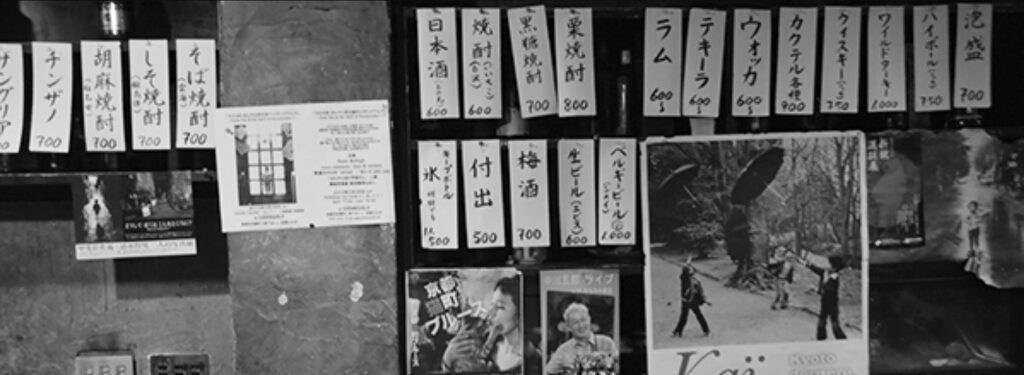During the corona curfew in early March of the year before last, I went to photographer Kai Fusayoshi’s legendary bar, Hachimonjiya. Many readers here will know that Kai has been taking beautiful photos of ordinary people just going about their lives, along the river and in the streets of Kyoto, ever since he got his hands on a camera as a boy.
Somehow I’d never been to his bar before. Were my wife alive, she would have been appalled by the state of this place. She would have summarily dragged me out and hosed me down or marched in with Varsan bombs and fumigated the premises before giving it a thorough cleaning. Hachimonjiya has been for decades a haunt for Kyoto’s artists, writers, and intellectuals, but, unlike Marie Kondō, Kai is a maximalist and doesn’t throw anything out. I went reasonably early, before 7 pm, because the “quasi-state of emergency” here called for last orders at 8 pm and 9 pm closing times everywhere.
Hachimonjiya is on the third floor of a non-descript building on Kiyamachi, a major thoroughfare of bars and clubs and restaurants. No sign on the door, which was festooned by sheaves of fading posters. I opened the door and saw a pile of junk in the middle of the room, stacks of old LPs and a cheap portable record player, the kind our generation would have got to play our first LPs when we were teenagers. To the left was a bar covered in bottles. A crackling record was playing Johnny Cash singing a cover of a Bob Dylan song:
No no no, it ain’t me, babe,
It ain’t me you’re looking for, babe.
Then amidst the pile of rubbish I saw something move—it was Kai, looking like Miss Havisham. No doubt under the mess was a mouldering wedding cake too. No one else was there.
This is the place where Kyoto’s best and brightest have hung out for decades. A wave of sadness washed over me. Here I thought I’d find a saloon full of smart people, and all I found was an old geezer on his own. I felt like this fucking pandemic has turned us all in Miss Havisham, waiting for our prince to come. But he doesn’t, does he? The scene was more Beckett than Dickens. All around, while war is being whipped up in Europe, I feel witness to the deaths of cultures and subcultures, the very stuff that keeps people alive and sane, here and everywhere else.
Kai said because of mambō he couldn’t serve liquor but if I wanted a Corona he could crack one open for me. He got up from his nest and went behind the bar. “Do you want a glass?” I looked at the glasses covered in dust and said just the bottle would be fine. We soon discovered we had a lot of mutual friends; this is no surprise because Kai seems to know just about everybody.
About a half hour or so later an old barfly entered with a bottle of 12 year-old Glenlivet which he proceeded to open. Kai got him a glass and some ice. I got to taking with the barfly and we discovered we had a mutual friend, playwright Sakate Yōji. Glenlivet had at one time tried to make it in Tokyo theatre during his university student days but was called back to Kyoto to take over the family business, which was a foundry for making Buddhist bells and other bronze images, using techniques passed down by Chinese artisans over 1,200 years ago. He launched into an interesting discussion on patina, how different alloys create vivid colours, like green, crimson, magenta, that are perfectly smooth under a magnifying glass where modern methods create pockmarked surfaces because of the off-gassing of various elements. It turned out we had another mutual friend, a musician and storyteller whom I’d known in Canada, a Japanese woman who periodically visited and performed there. I’d lost touch with her a dozen years or so ago. He called her and over the phone we very quickly picked up the threads of our frayed friendship.
One speaks of six degrees of separation, but in this town it’s easily only one or two degrees. It’s a small world. Kyoto is even smaller, and Hachimonjiya is its omphalos.
Read another colourful tale by Cody of Kyoto’s nightlife.
See Sara Aoyoma’s intimate account of Kai in the 1970s.
Read an account of an exhibition of Kai’s photos.

